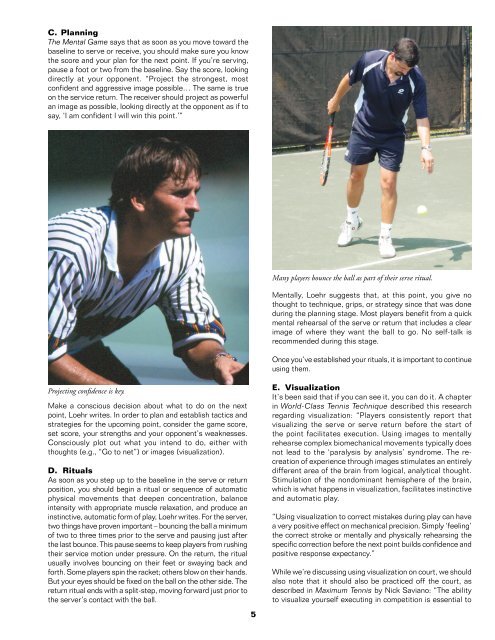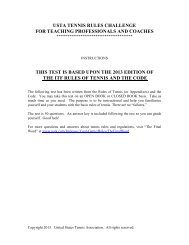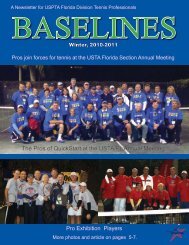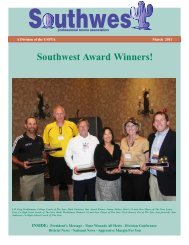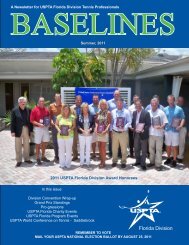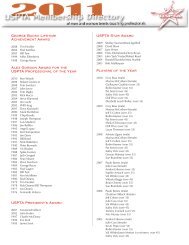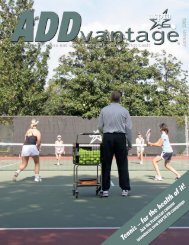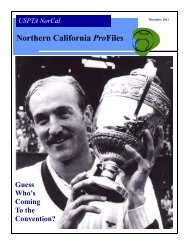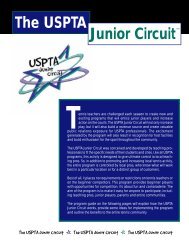Volume 2, No. 3 - United States Professional Tennis Association
Volume 2, No. 3 - United States Professional Tennis Association
Volume 2, No. 3 - United States Professional Tennis Association
You also want an ePaper? Increase the reach of your titles
YUMPU automatically turns print PDFs into web optimized ePapers that Google loves.
C. Planning<br />
The Mental Game says that as soon as you move toward the<br />
baseline to serve or receive, you should make sure you know<br />
the score and your plan for the next point. If you’re serving,<br />
pause a foot or two from the baseline. Say the score, looking<br />
directly at your opponent. “Project the strongest, most<br />
confident and aggressive image possible… The same is true<br />
on the service return. The receiver should project as powerful<br />
an image as possible, looking directly at the opponent as if to<br />
say, ‘I am confident I will win this point.’”<br />
Many players bounce the ball as part of their serve ritual.<br />
Mentally, Loehr suggests that, at this point, you give no<br />
thought to technique, grips, or strategy since that was done<br />
during the planning stage. Most players benefit from a quick<br />
mental rehearsal of the serve or return that includes a clear<br />
image of where they want the ball to go. <strong>No</strong> self-talk is<br />
recommended during this stage.<br />
Once you’ve established your rituals, it is important to continue<br />
using them.<br />
Projecting confidence is key.<br />
Make a conscious decision about what to do on the next<br />
point, Loehr writes. In order to plan and establish tactics and<br />
strategies for the upcoming point, consider the game score,<br />
set score, your strengths and your opponent’s weaknesses.<br />
Consciously plot out what you intend to do, either with<br />
thoughts (e.g., “Go to net”) or images (visualization).<br />
D. Rituals<br />
As soon as you step up to the baseline in the serve or return<br />
position, you should begin a ritual or sequence of automatic<br />
physical movements that deepen concentration, balance<br />
intensity with appropriate muscle relaxation, and produce an<br />
instinctive, automatic form of play, Loehr writes. For the server,<br />
two things have proven important – bouncing the ball a minimum<br />
of two to three times prior to the serve and pausing just after<br />
the last bounce. This pause seems to keep players from rushing<br />
their service motion under pressure. On the return, the ritual<br />
usually involves bouncing on their feet or swaying back and<br />
forth. Some players spin the racket; others blow on their hands.<br />
But your eyes should be fixed on the ball on the other side. The<br />
return ritual ends with a split-step, moving forward just prior to<br />
the server’s contact with the ball.<br />
5<br />
E. Visualization<br />
It’s been said that if you can see it, you can do it. A chapter<br />
in World-Class <strong>Tennis</strong> Technique described this research<br />
regarding visualization: “Players consistently report that<br />
visualizing the serve or serve return before the start of<br />
the point facilitates execution. Using images to mentally<br />
rehearse complex biomechanical movements typically does<br />
not lead to the ‘paralysis by analysis’ syndrome. The recreation<br />
of experience through images stimulates an entirely<br />
different area of the brain from logical, analytical thought.<br />
Stimulation of the nondominant hemisphere of the brain,<br />
which is what happens in visualization, facilitates instinctive<br />
and automatic play.<br />
“Using visualization to correct mistakes during play can have<br />
a very positive effect on mechanical precision. Simply ‘feeling’<br />
the correct stroke or mentally and physically rehearsing the<br />
specific correction before the next point builds confidence and<br />
positive response expectancy.”<br />
While we’re discussing using visualization on court, we should<br />
also note that it should also be practiced off the court, as<br />
described in Maximum <strong>Tennis</strong> by Nick Saviano: “The ability<br />
to visualize yourself executing in competition is essential to


